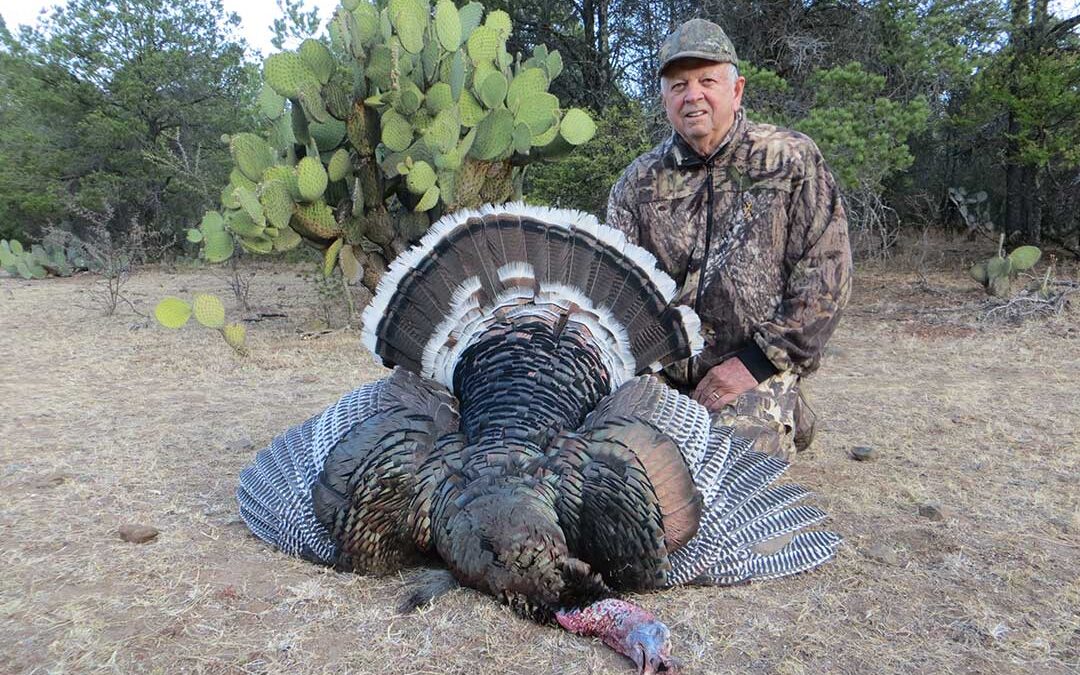It was April 17 and we were high in the Sierra Madre Occidental mountains, three hours’ drive from Durango, Mexico. The temperature was a pleasant 45 degrees and the climate very dry. I was right where I wanted to be in the middle of the original range of the Gould’s turkey species. It was my second attempt, the first being the previous afternoon when only two jakes thought my calls worthy of attention.
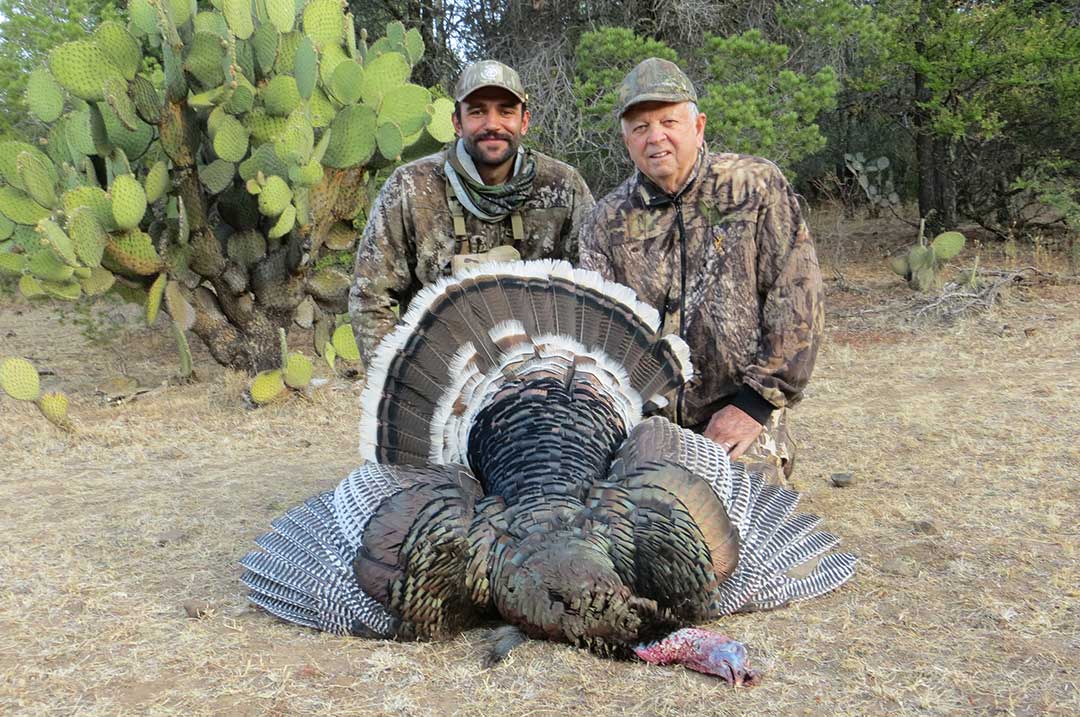
Newberry and the outfitter, Diego Olaguibel, with the Gould’s turkey.
I was excited and had high expectations as the Gould’s was the only one left standing between me and a world slam on the six species. My research had revealed a very healthy population of birds on La Michililla, the 41,000-acre preserve on which Diego Olaguibel has exclusive hunting rights. The first group of hunters in camp this year had each taken a bird and some had collected two.
Our group included John Gallagher from Wheatfield, Indiana, his son Johnny and his brother Josh, along with Keith Wilder from Michigan, one of John’s best friends. I knew none of them before arriving, but in four short days we became great friends. They are that kind of people, and all were experienced, well-seasoned hunters. Unusual as it may seem, we had each taken five species of turkeys and were now chasing the Holy Grail of turkey hunting, The World Slam.
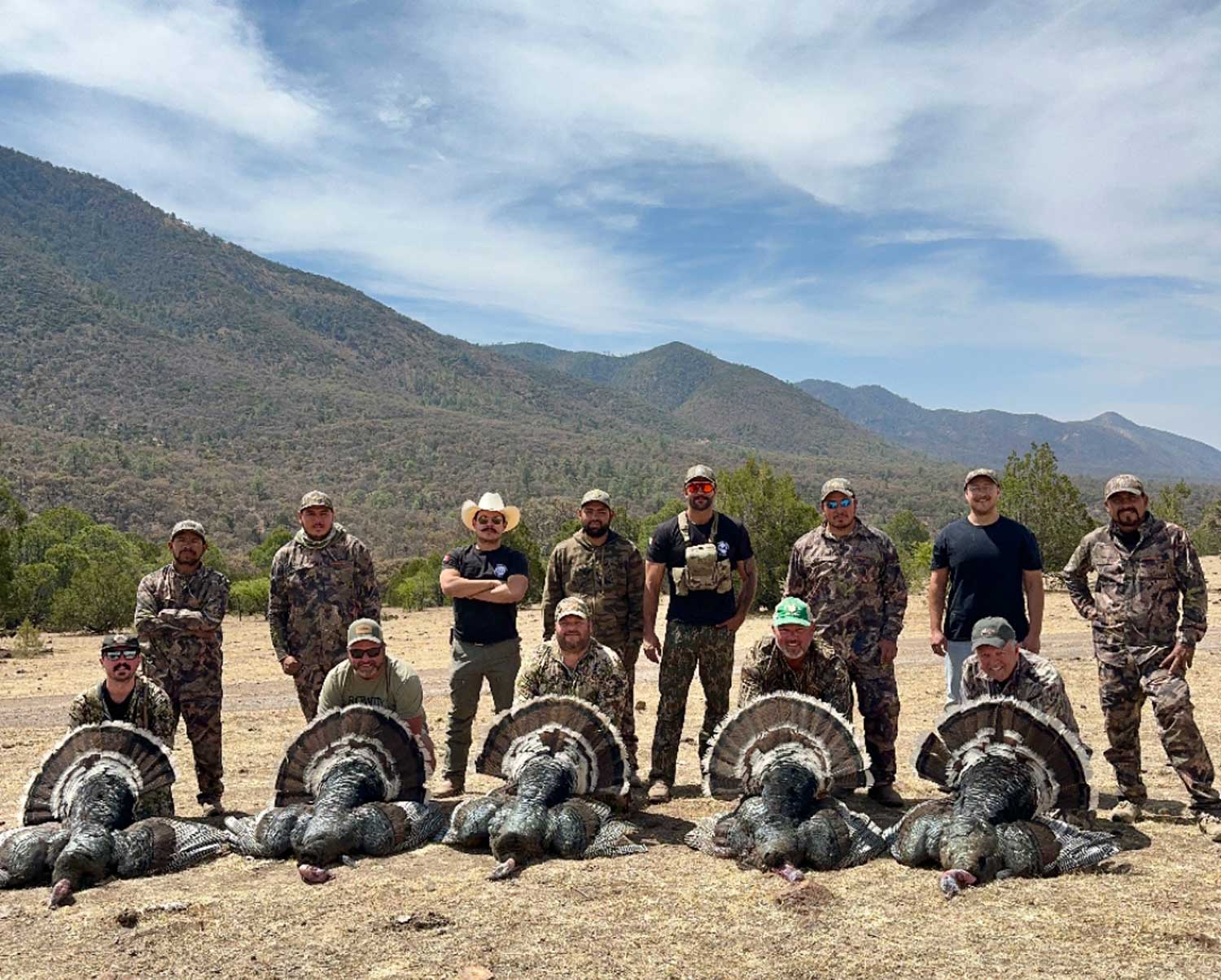
Hunters and guides with five Gould’s Gobblers.
Having enjoyed 75 years of hunting since shooting my first rabbit at age eight and having hunted in 69 countries for a wide variety of big game and gamebird species, my life had settled into chasing Eastern gobblers and whitetail deer on my property in coastal Georgia. But I had made a commitment to myself years ago to collect all six of the turkey species. And as my favorite poet, Robert Service said, “a promise made is a debt unpaid.”
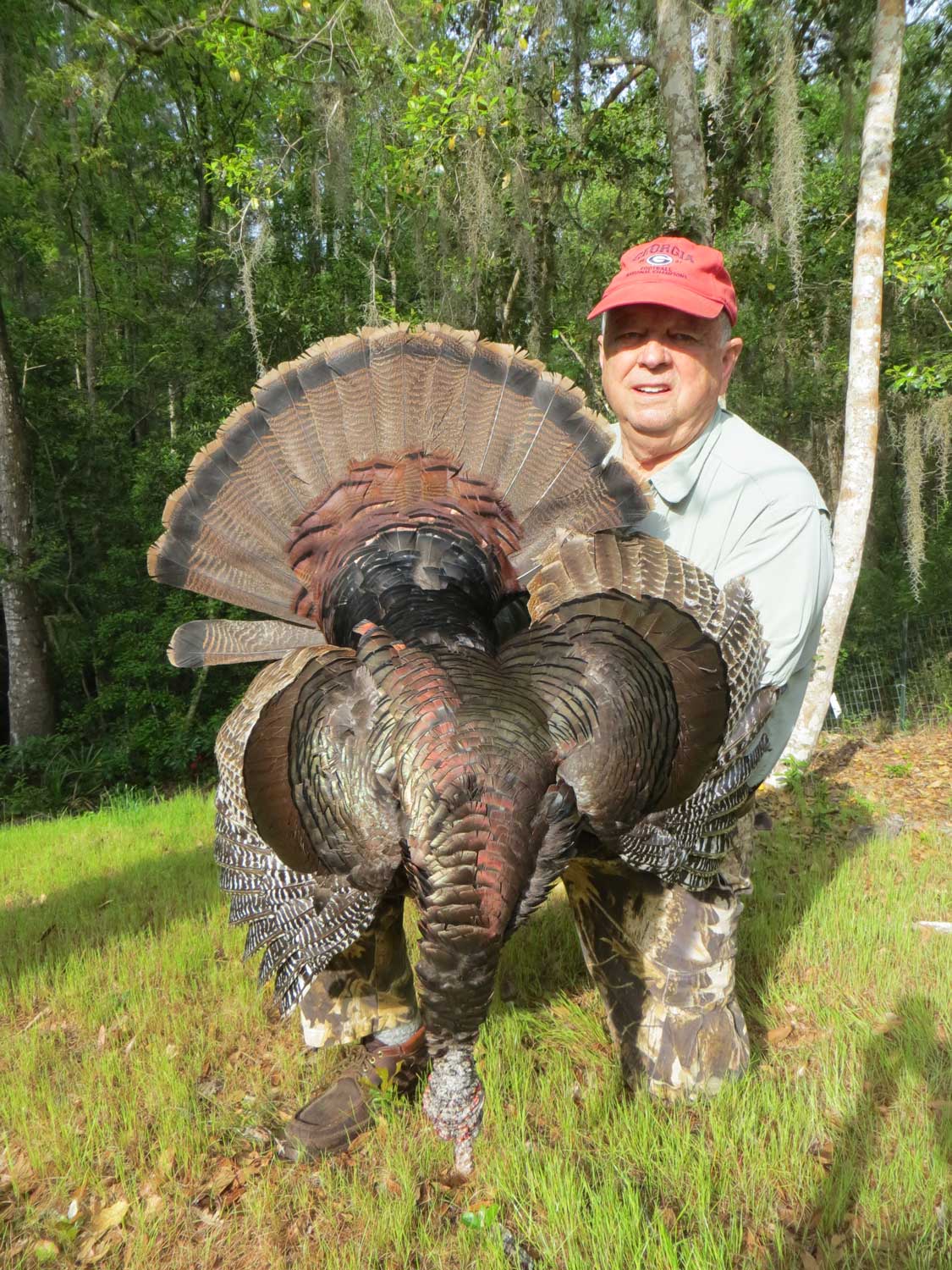
Newberry, age 83, with another Eastern Gobbler taken on his farm, April, 2024.
I took my first, an Eastern, while in graduate school in Athens, Georgia. Over the years, my love of chasing the big birds became addictive and in 2024, I called in my 187th bird to the gun. Many of these Eastern gobblers were either taken or missed by friends.
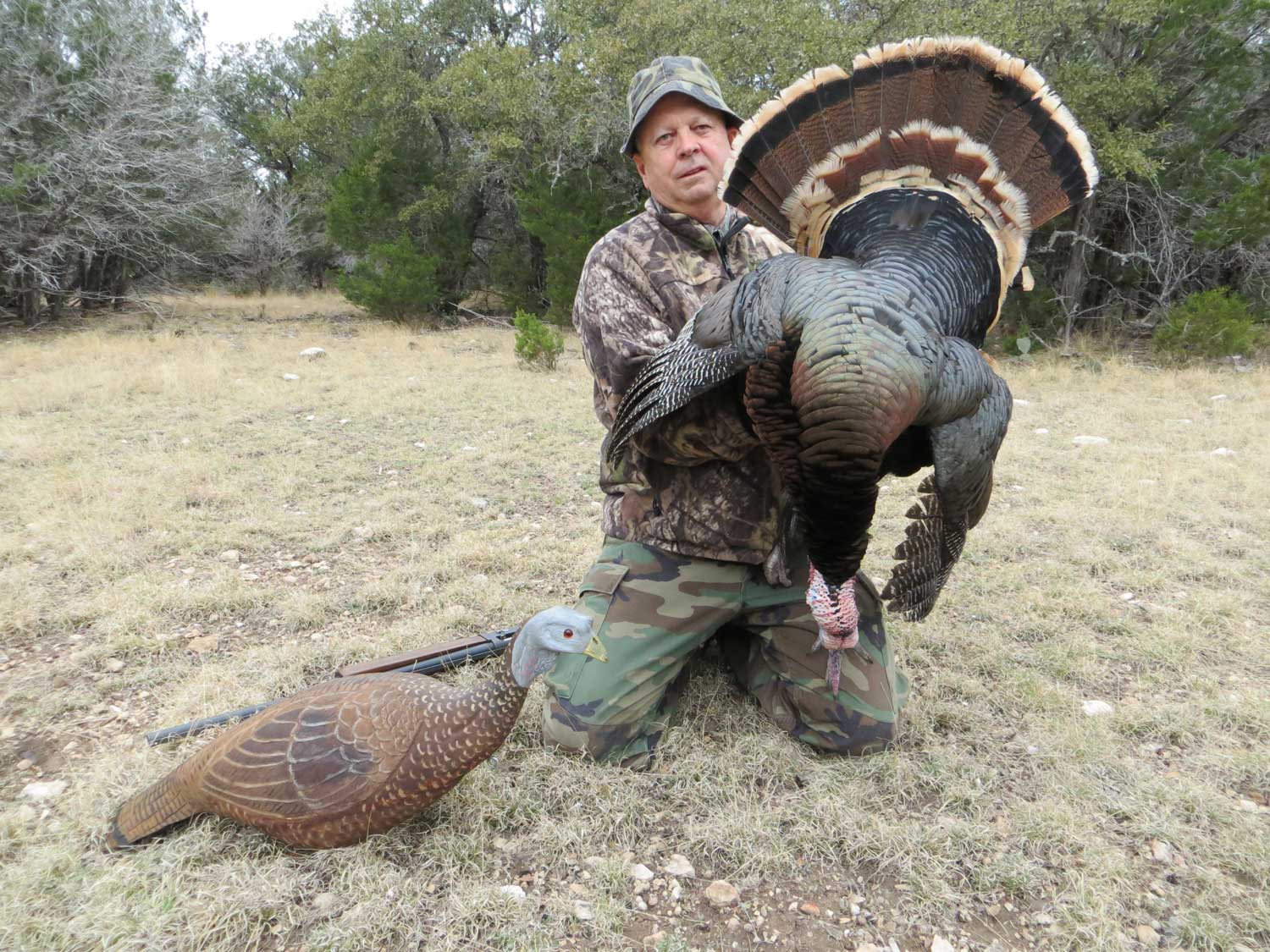
The author with his first Rio Grande and Kaw-liga, his wooden decoy.
In 2013, I logged my first of several Rio Grande turkeys in Texas on the Rio Bonito Ranch. I have also hunted them on the Yturria Ranch in south Texas and on several private estates.
The Rios vary a bit in coloration, depending on the geographical location, with the primary difference being found on the tips of the tail and on the rump feathers. Some are a very light beige and others a more dirty beige.
At the 2014 Safari Club Convention, I met Alfredo Lamadrid, who owns Balam Hunting Expeditions and has a 180,000-acre lease in the Yucatan jungle south and east of Campeche, Mexico. I booked a hunt with him for the ocellated turkey and several other jungle species.
My old high school buddy, Jimmy Goolsby and I flew into Campeche in March where we overnighted. The next day was a seven hour drive south on a rock strewn and rutted road where 15 miles per hour was average speed. Our destination was a camp of thatched huts recently hacked out of the jungle. It was laid out nicely with hammocks for sleeping and a clear-water stream for bathing. We had lots of fresh fruit and all the meals were good, though I seldom knew what I was eating.
The big plus for this area was the plentiful game. Everything one thinks about in the way of jungle wildlife was there, from snakes to jaguars. Howler monkeys serenaded us all night and ruined one of my hunts when I was working a gobbler.
On the second day, Goolsby took his ocellated and we both collected a greater curassow, crested guan and several chachalacas. Along with the ocellated, these unique critters make up the jungle slam on gamebirds. I also got a collared peccary at a waterhole and Jimmy collected a coatimundi, which later that night ended up in our tacos.
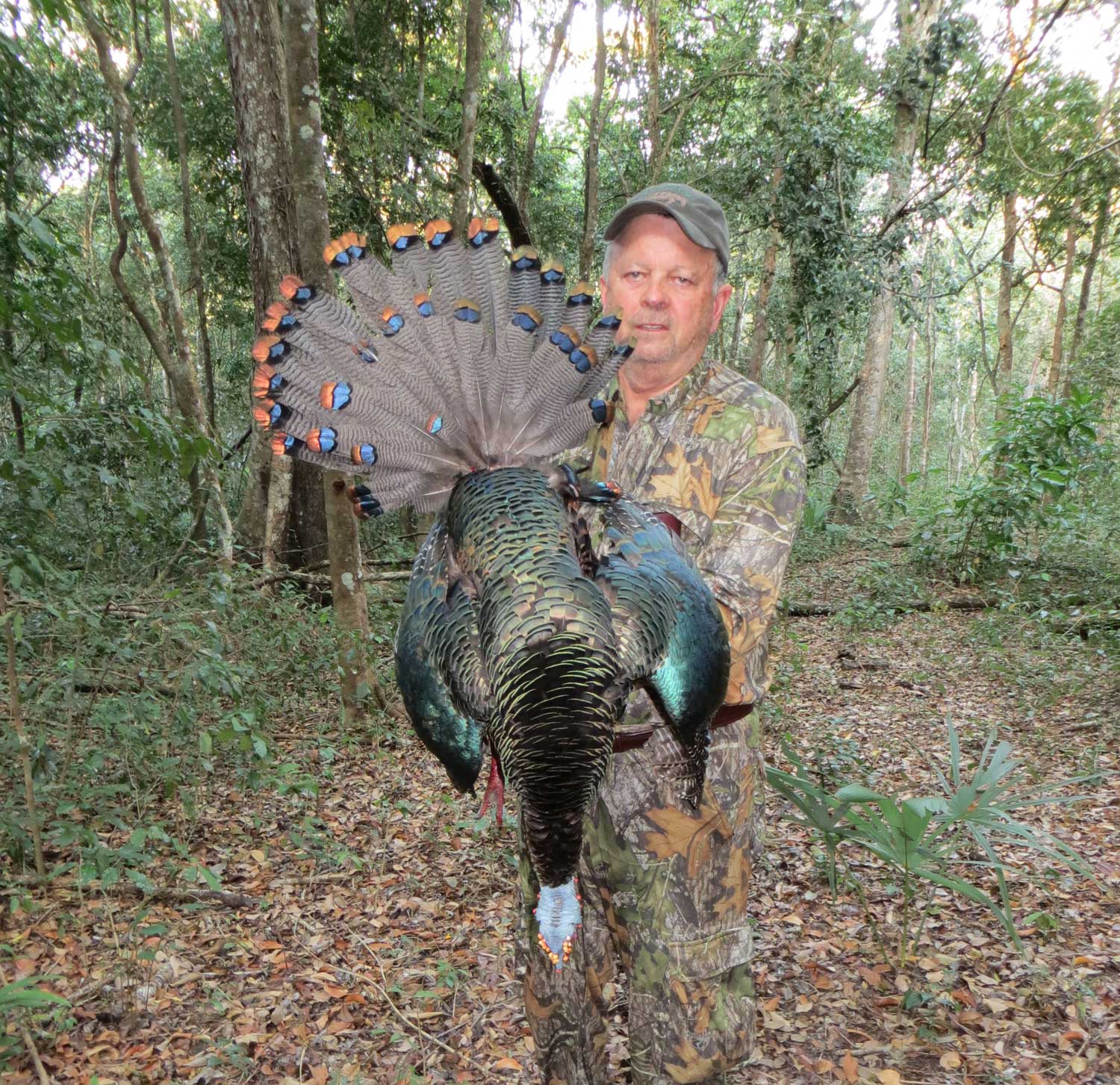
Author with ocellated turkey, Yucatan Jungle, Mexico.
By the time the fourth and last day arrived, I was still having bad luck getting my bird. I had worked three but encountered typical turkey trouble. Then, on the last afternoon, it all came together as though it was meant to be. We parked the jeep, expecting a long, slow walk of occasional calling and listening. But after our first call only 20 yards from the vehicle, a bird answered. In less than a minute, I saw his white head rise above the dense vegetation and my 40-yard shot gave him his ticket back to Georgia.
In creating the ocellated turkey, Mother Nature used up all the colors in her palette and then just dreamed up some more. It’s difficult to describe the beauty of this bird; a simple listing of its colors does it little justice. It has no beard, but its spurs often exceed two inches. The tail feathers are bluish-gray with blue-bronze circles and bright gold tips. The tail spots, ocelli, are similar to those of a peacock. The upper wings are iridescent copper, the head is bluish-white with bright orange nodules and its legs are bright red. Truly a trip for these grand gamebirds of the jungle is a must do for any hunter looking for something exciting and different.
I had completed my Africa Big Five book and was winding up hunting in 33 countries in Europe for another title, European Hunter. My next book on duck decoys was taking a lot of time, so I wasn’t pushing hard achieving the turkey slam. Then a friend mentioned a great Osceola hunt he had just completed in Marion County, Florida, a little north of Silver Springs. This was less than three hours’ drive from my home on the Georgia coast, so I soon had his guide, Jim Sprengel, on the phone. His outfit, “Getta Gobbler,” has access to multiple private estates with healthy Osceola populations.
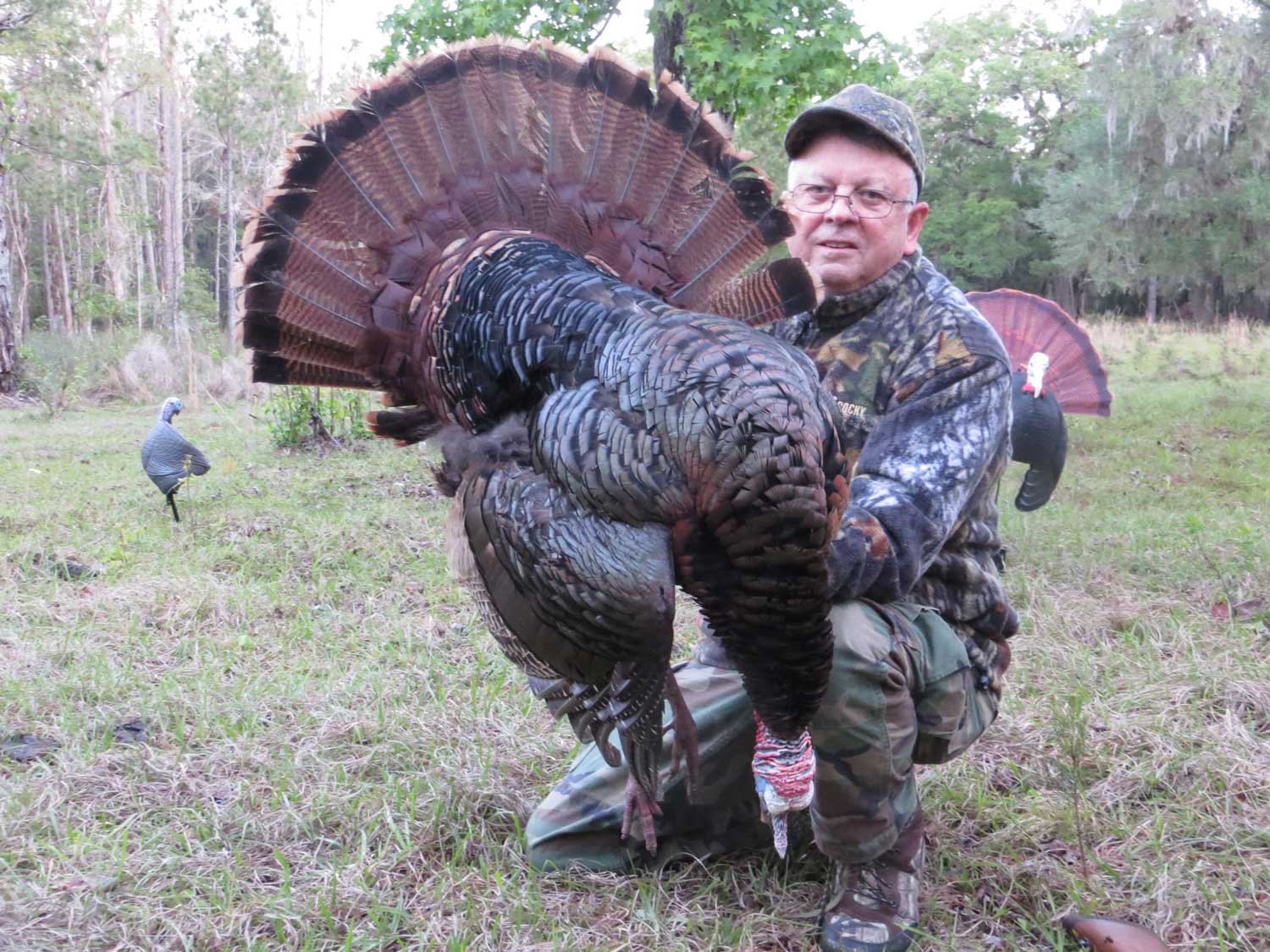
Newberry with Oceola Gobbler, Marion County, Florida.
Martha and I were soon on our way to Florida, her because she likes to travel and me for the hunt. We met Jim in Silver Springs and discussed plans for the next two days’ hunt. Much of his hunting area has large, swampy tracts with small, adjacent dry ground clearings. Several turkey species love this type of habitat, but it’s especially suited to the long-legged Florida Osceola turkeys. Jim had done his homework well and his pre-scouting paid off quickly. We sat in a small meadow and at crack-of-dawn, two gobblers sounded off in the nearby flooded cypress. One soft tree call and they both came down, one within 40 yards.
It was easy enough, so I decided to repeat the hunt again the next year. Typical of the way it goes with turkey hunting, that experience proved quite different. The first two areas we hunted had resident sandhill cranes that croaked and squawked all morning. Apparently, no self-respecting gobbler wanted to be seen in the company of these loud-mouths, so we called it a day.

The author with a second Oceola Gobbler.
Finally, on the last morning, I enticed a bird to approach the two-acre meadow where we were sitting. It took a couple of hours, but he finally worked his way into range of my Ithaca autoloader and gave me another Osceola.
The Merriam’s turkey was next on my schedule. Martha wanted to see a lot of the famous landmarks out west, such as Yellowstone, Mount Rushmore, Custer’s Last Stand and Jackson Hole. I felt we could combine that with a hunt for Merriam’s if we could find a turkey guide. Scott Croner of Brewster, Nebraska, popped up on the internet. A quick check with references left me feeling good about a hunt with him.
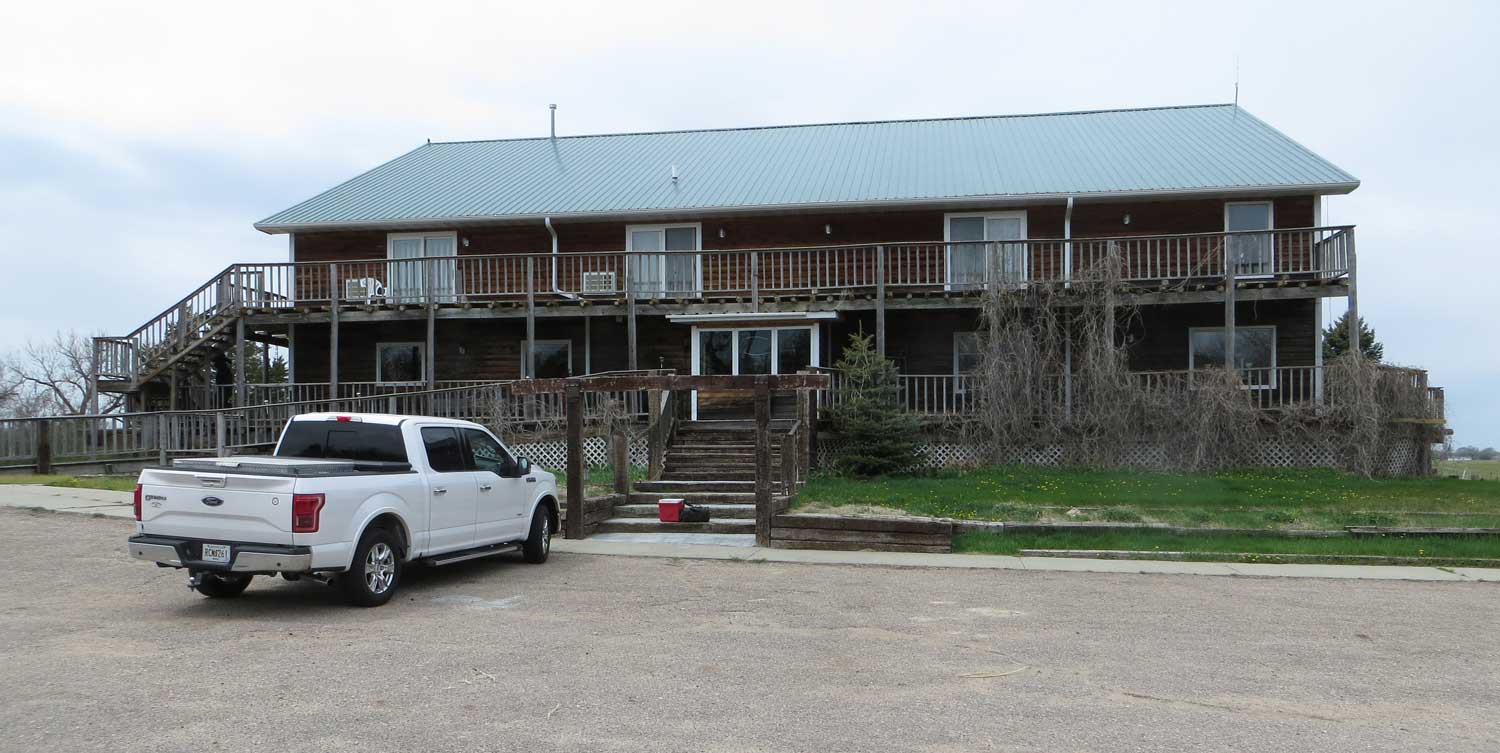
The lodge at Brewster, Nebraska.
Scott places his hunters in “Uncle Bucks,” a wonderful 14,000-square-foot western lodge in the middle of a 10,000-acre working cattle ranch. Family owned and operated since 1881, the ranch features an atmosphere that is straight out of the Old West. Scott also had access to multiple ranches with good populations of Merriam’s.
On my first morning out with Scott, I learned a new technique that I had never tried. It employs the tail feathers of a gobbler spread open in the pirouette position to attract a bird. If that fails, you can hold the feathers in front of you as you slowly move within shooting range.
I was somewhat skeptical, but my attitude changed when I saw how well it worked. Called “fanning,” it’s employed by many hunters pursuing turkeys in partially open to wide-open terrain. The fan won’t hide your entire body, but the gobbler is so fixated on love-making and protecting his harem from an intruding gobbler, that he will stand his ground and not scamper off. If you are forced to crawl, wearing camo that blends with the grasslands and leather gloves and kneepads for the thorns are a must.
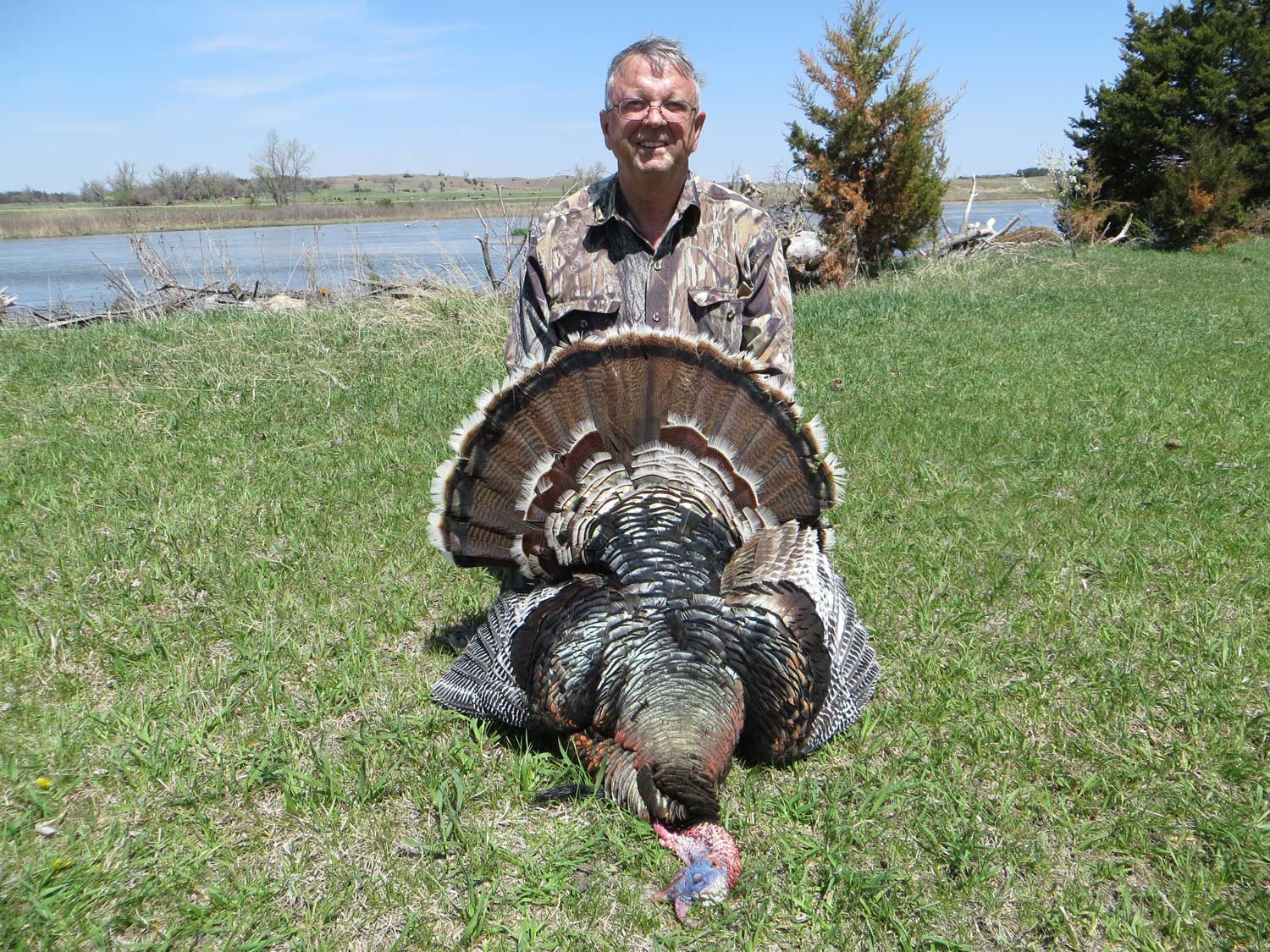
The author with Merriam’s Gobbler.
We enjoyed several exciting episodes of this fan-and-crawl technique each of the two days and the results were two beautiful Merriam’s gobblers. I do not think, however, that I would be tempted to use this technique at home where the forests are much more dense and do not allow for long-range visibility. What’s more, someone I might not see could put an illegal rifle shot through my fan, which would easily ruin my day.
So now, all I needed was the Gould’s to complete my World Slam. Should be easy enough or so I thought.
In January of 2025, I attended the Safari Club Convention in Nashville, where, I was drawn to the “Yukkutz Hunting” booth. There, I met Manuel Olaguibel, the owner of this Mexican operation. He offered hunts for many species including ducks, quail, Coues deer, whitetail, exotics and all the jungle species. The name “Yukkutz” means “yuk” for brocket deer, and “kutz” for ocellated turkey. But the species that caught my attention was the Gould’s. I had to beg a little, but he was kind enough to work me in for the 2025 season.
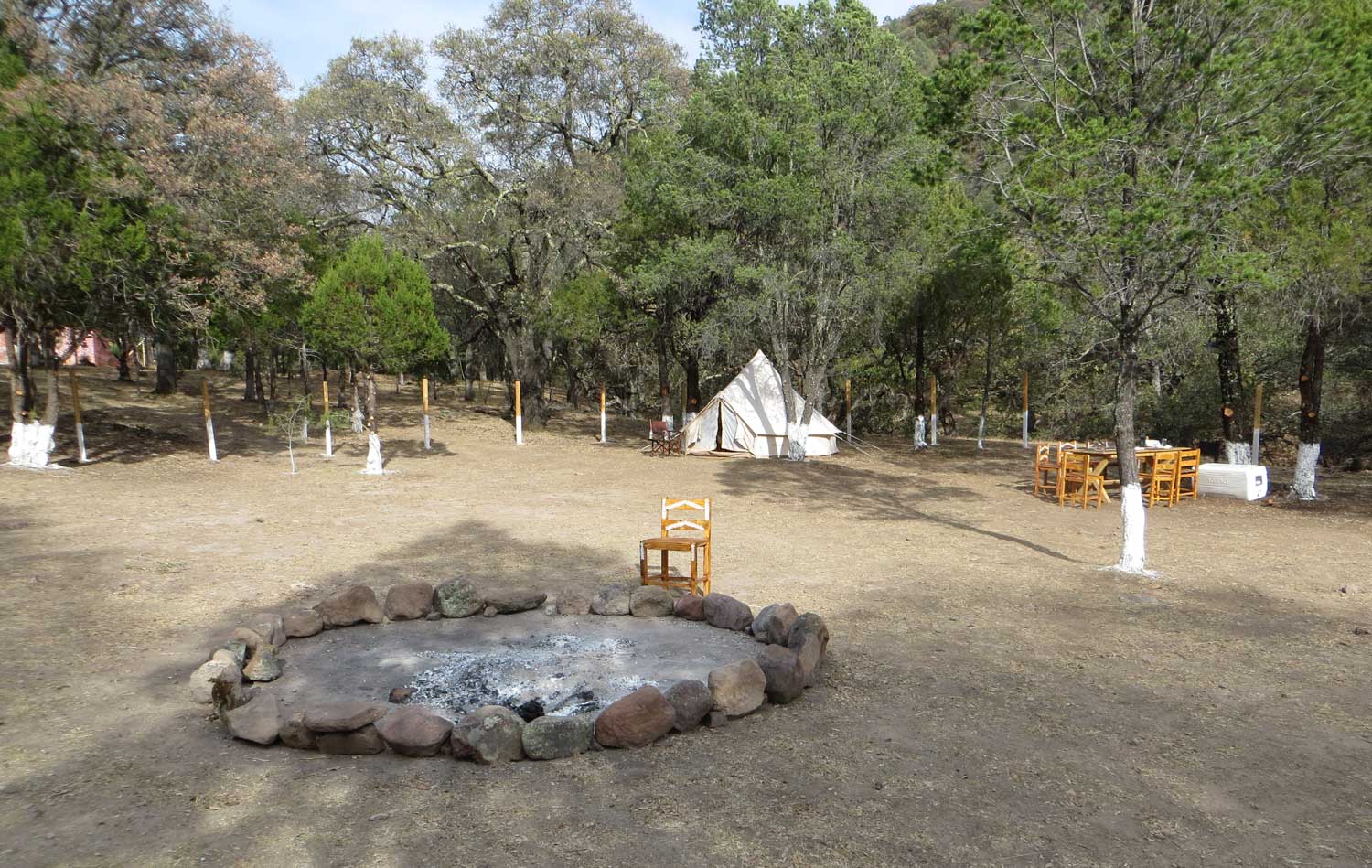
The Gould’s camp in the Sierra Madre Occidental Mountains.
So here I am on the second day of the hunt, stepping into the blind with Diego, Manuel’s son who runs ground operations in all their hunting areas. The small juniper structure was placed in quarter-acre clearing facing the steep side of a heavily forested mountain. We were using no decoy this morning as Luis, the guide, thought the birds would fly down into the clearing where they would be in range of the gun.
Ten minutes after first light, a gobbler sounded off straight across from us on the mountainside. Then another and then a third bird let go. Their gobbles were loud, like shaking a can full of marbles, which to my poor hearing meant close. But as the old saying goes, “close only counts with horseshoes and hand-grenades.” Although these birds answered every call we made, they soon flew down on the mountainside and evidently made off with their hens.
I love the Gould’s coloration. The tail feather tips and the rump feathers are snow white. The bright rump patch makes it much easier to spot them moving through the brush.
There was a lot of turkey sign in the meadow, including droppings and strut-marks. So, we decided to stay put for a while, making soft yelps and purring a bit every 15 minutes, hoping for something to happen. A half-hour later, I was thinking about another great breakfast back at camp when I heard a very soft yelp from behind the blind. I answered with only three strikes on my Neil Cost box call and Luis heard a gobbler respond some distance behind us. I couldn’t hear it.
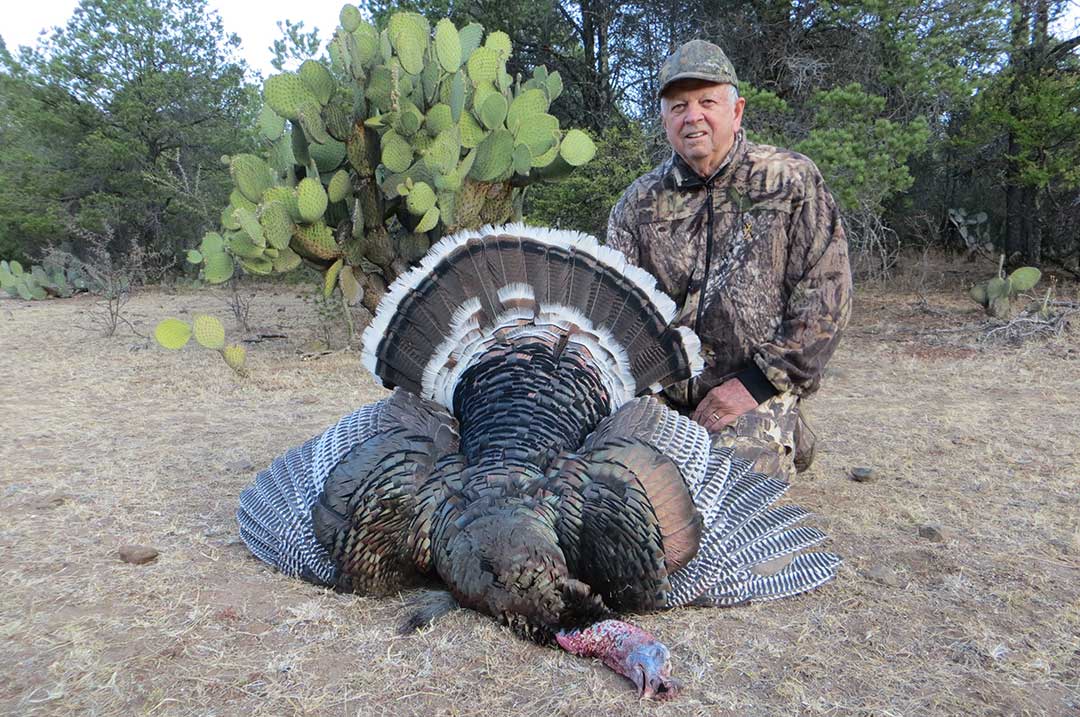
Five minutes later, five hens and a jake with a five-inch beard came strolling by the blind and into the meadow. I looked hard at the jake. After all, he could be my “World Slam.” But since this was only my second hunt, I let him pass.
I was still focused on the jake when I heard that captivating sound of a boss gobbler, which was low-pitched enough for me to hear. He started drumming – right behind us. And then he suddenly appeared, followed by another mature bird.
Keeping his eye on the jake, the boss gobbler followed the hens across the clearing and then stopped, 30 yards in front of my blind. In doing so he punched my ticket onto the “World Slam” list and I punched his ticket on American Airlines to Georgia.
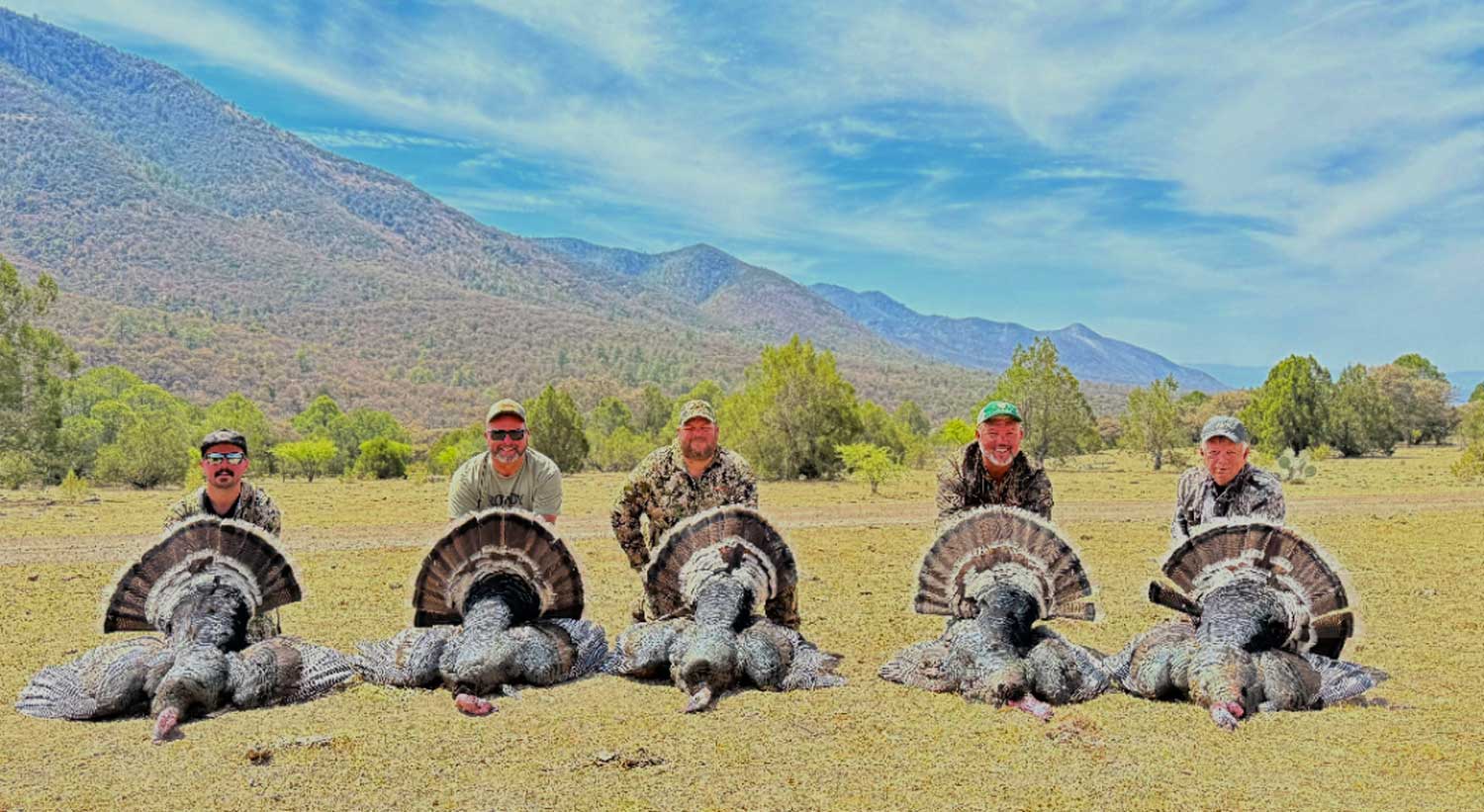
Five hunters with their five Gould’s.
We returned to camp to discover that three of the other four hunters had collected their gobblers and the fourth took his on the third day. Lots of celebration! Good cigars, cold beer and a steak dinner with all the trimmings was next on the menu.
Note: To book your own Goulds hunt, contact Diego at diegoyukkutz@gmail.com. Diego runs a tight ship. His guides, food, accommodations and service are all first class. Even better, his turkey populations are the best I have seen. I am told that his ocellated areas are just as good.

